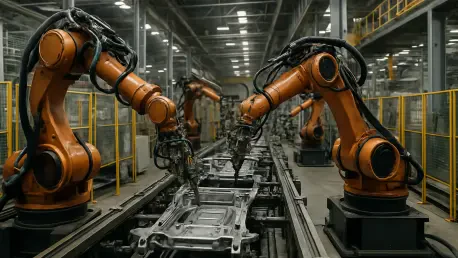Setting the Stage: A Looming Shift in the U.S. Job Market
In 2025, the American workforce stands at a critical juncture as automation technologies, particularly artificial intelligence (AI) and generative AI systems, advance at an unprecedented pace, creating significant challenges and uncertainties. A staggering statistic underscores the urgency of this moment: approximately 23 million jobs, accounting for about 15% of all U.S. positions, are at high risk of being automated. This figure paints a vivid picture of potential disruption across industries, raising pressing questions about the future of work. This market analysis delves into the trends, data, and projections surrounding automation’s impact, exploring which sectors face the greatest threats, how jobs might transform rather than disappear, and what strategic responses could mitigate widespread displacement. The purpose is clear—to equip businesses, workers, and policymakers with actionable insights into navigating this technological upheaval.
Diving Deep: Market Trends and Projections in Automation
Sectoral Vulnerabilities: Where Automation Strikes Strongest
The automation wave sweeping through the U.S. job market reveals stark disparities across industries. Computer and mathematics-related occupations emerge as the most exposed, with 32% of roles classified as highly automatable—meaning at least half of their tasks can be performed by technology. Within this group, nearly 13% of positions face no significant barriers to full automation, driven largely by reliance on generative AI for complex task execution. In sharp contrast, industries such as personal care, healthcare, and education show far lower risk, with only 6% of jobs deemed highly automatable due to the essential human interaction these roles demand. This uneven exposure highlights a critical market trend: technology-driven sectors are on the frontline of change, while human-centric fields retain a protective buffer.
Transformation Over Replacement: A Nuanced Market Outlook
While the risk of job loss looms large, the market analysis suggests that outright displacement is not the predominant forecast for most roles. Data indicates that 63% of U.S. jobs are shielded by nontechnical barriers, including legal restrictions, cost inefficiencies, and client preferences, with the latter being a factor in nearly three-quarters of affected positions. For instance, in industries like aviation, even advanced autonomous systems cannot fully replace human pilots due to passenger trust in human oversight. This trend points to a future where job transformation—integrating technology into existing roles—outweighs complete automation, reshaping the labor market into one of collaboration between humans and machines rather than competition.
Adoption Challenges: Practical and Ethical Roadblocks
The integration of automation technologies, especially generative AI, into the workplace is not without hurdles, shaping current market dynamics. Recent studies reveal that 95% of enterprise generative AI initiatives have failed to yield measurable financial returns, exposing a gap between technological promise and practical impact. Small businesses, in particular, struggle with the high costs of implementation, while larger corporations grapple with ethical concerns such as bias in AI systems. Additionally, regional variations and industry-specific demands further complicate adoption rates, creating a fragmented market landscape. These challenges suggest that while automation is a powerful force, its rollout will be uneven, influenced by both economic realities and societal considerations.
Future Trajectories: What Lies Ahead for the Workforce
Looking toward the coming years, from 2025 to 2027, automation’s trajectory in the U.S. labor market will likely be defined by a blend of technological innovation and adaptive strategies. Emerging trends point to a rise in hybrid roles where human expertise complements AI capabilities, especially in high-risk sectors. Economic pressures may slow automation adoption among smaller firms, while larger enterprises could accelerate integration, widening market disparities. Regulatory frameworks addressing data privacy and workplace equity are also expected to shape how automation unfolds, potentially curbing overreach in certain industries. Projections indicate a growing focus on reskilling programs, with both corporate and government initiatives aiming to prepare workers for evolving job demands, signaling a market shift toward resilience over replacement.
Reflecting on the Past: Strategic Insights and Forward-Looking Actions
Looking back on this analysis of automation’s impact on the U.S. job market, the findings underscore a dual reality of risk and opportunity for 23 million jobs. The deep dive into sectoral vulnerabilities, transformation trends, and adoption challenges paints a complex picture of a workforce in transition during 2025. Key implications emerge, notably the need for proactive measures to address uneven exposure across industries and the persistent barriers to full automation. Moving forward, businesses are encouraged to invest in reskilling initiatives that foster human-AI collaboration, while professionals need to prioritize skills in areas resistant to automation, such as creative problem-solving. Policymakers, in turn, have a critical role in supporting workforce development through targeted funding and balanced regulations. These strategic steps, grounded in the insights gained, offer a pathway to turn automation’s challenges into a catalyst for a more adaptive and inclusive labor market.









